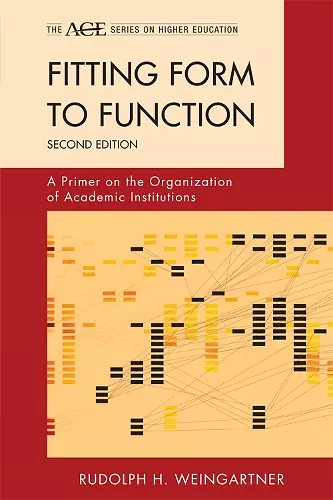Fitting Form to Function
A Primer on the Organization of Academic Institutions
Format:Paperback
Publisher:Bloomsbury Publishing PLC
Published:21st Jun '11
Currently unavailable, and unfortunately no date known when it will be back

Institutions of higher education are not like corporations: they have multiple goals, not even limited to the central ones of teaching and research, nor are they organized hierarchically. One class of leading inhabitants, faculty members, are a cross between independent contractors and employees; another class, administrators, are a cross between bosses and colleagues. Fitting Form to Function discusses how such institutions are best organized; how decisions are best made at various levels; how administrators and faculty can effectively collaborate in giving shape to a university or college. The book takes up such topics as the office of the president, of the provost, the dean and the chairperson of a department. It considers how committees are formed to function effectively-from a faculty senate to budget and planning committees to those that advise on promotions and others that adjudicate when there are grievances. Fitting Form to Function is written in an informal style. No jargon, no footnotes, but sporting 27 recurring maxims, such as Maxim 1, In academic institutions, the forces of nature are centrifugal; organizational art must be used to create propensities toward coherence; Maxim 17, Boundaries are less likely to create solidarity among those who live within them than they constitute barriers for those residing outside them; and Maxim 23, 'A' people hire (or retain) 'A' people, while 'B' people hire 'C' people.
This book discusses how institutions are best organized, how decisions are best made at various levels, and how administrators and faculty can effectively collaborate. * Presidency *
Every faculty member who wants to understand how decisions are made on campus should invest in this volume. * Academe *
Here's a guide to good decision making that's worth the time spent no matter where in the decision-making chain one might find oneself. The author sees organization as an art, and practitioners of that art who succeed in fitting form to function, as creators of institutions that are more effective in carrying out their missions. Interspersed with a set of 'maxims' by which to live an institutional life, Fitting Form to Function is a call to administrators to conduct more enlightened administration. Spending a few hours with this book is the equivalent of spending time with a well-tempered, wise, and discerning colleague. You cannot help but return to your work thinking, 'We can find a way to do this better. ' -- JoAnne Boyle, president, Seton Hill University
Members of the faculty and administrators—and even trustees and students of higher education—will find this roadmap of the academic terrain useful. Focusing on the special nature of academic entities and the practical implications that follow it touches all of the traditional dimensions of academic life. -- Stanley Ikenberry, former president, University of Illinois
A refreshingly accessible work and a very good primer for students. Students and professors alike will enjoy the maxims and Weingartner's philosophical insights strewn throughout the text. -- Michael Siegel, Suffolk University
Too often, people who work in higher education institutions understand only their small corner of the often large and complex enterprises of which they are a part. Fitting Form to Function, Second Edition, will help broaden the readers' understanding of the various roles and responsibilities of university administrators and faculty groups. It will also help them to understand how each unit or division of a college or university fits into the larger mission of the campus. Most importantly, it will help the reader be more successful in their navigation of the power and politics of their campus through their understanding of how the organization works. This book has been a required text in my PhD cognate and post-master's-level higher education course for several years. It has served my students well, but the second and fuller edition promises to be an even better fit. -- Sandra Packard, Oakland University
Fitting Form to Function is a marvelous, spare guide to organizing colleges and universities.There is nothing quite like it for providing wise counsel for both the novice and the experienced member of the academic community. -- Douglas Bennett, president, Earlham College
Rudolph H. Weingartner notes that his central aim in writing Fitting Form to Function was to help make academic institutions 'more effective in carrying out their missions.' Since its original publication fifteen years ago, this book has more than fulfilled that goal, becoming an indispensible guide for administrators, faculty and leaders of higher education institutions who recognize that colleges and universities are unique entities serving multiple purposes that extend beyond their central roles of teaching and research. In a time of great complexity and challenges for higher education, Weingartner’s new, updated version of his book offers much wisdom about how collaboration, insightful decision-making and an understanding of how the academic world really operates can make all the difference in an institution’s success as well as in that of the people whose work, education and careers may hang in the balance. -- Vartan Gregorian, President, Carnegie Corporation of New York
The second edition of Fitting Form to Function is even better: fuller, clearer, and attentive to new issues. As ever, Weingartner is the perfect meld of judiciousness and experience – he has been there, seen it and done it. I would like to think that all higher education administrators (and a great many faculty members) will read Fitting Form to Function. If its precepts were heeded, we would have a much better chance of negotiating the currently perilous waters of academic organizational behavior than I think we actually do. -- Stanley N. Katz, Princeton University
ISBN: 9781442211995
Dimensions: 232mm x 157mm x 12mm
Weight: 259g
168 pages
2nd edition